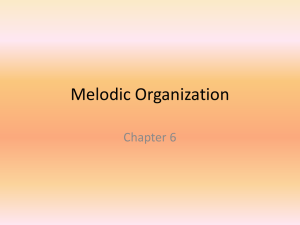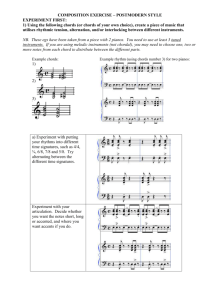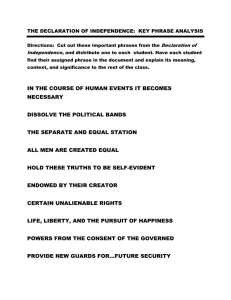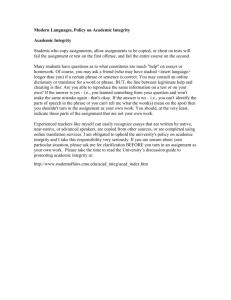Unit 13 - cshchoir.org
advertisement
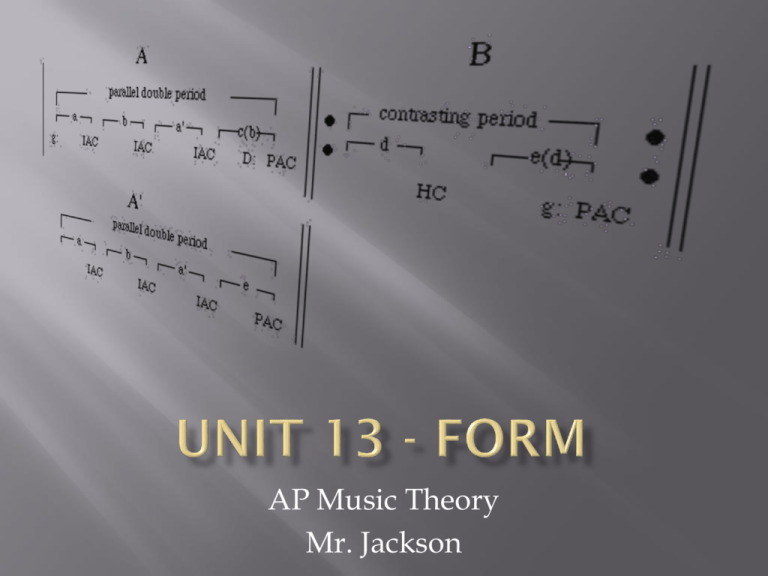
AP Music Theory Mr. Jackson The smallest identifiable musical idea. Can consist of a pitch pattern, rhythm pattern, or both at the same time. Phrase – a relatively independent musical idea terminated by a cadence. Subphrase – a distinct portion of a phrase. It is not a phrase because it is not terminated by a cadence or because it is too short to be relatively independent. Phrases are combined to form larger structural units called periods. Period - Two phrases in an antecedent -consequent relationship. Antecedent: (Question) – Less conclusive cadence Consequent: (Answer) – More conclusive cadence Phrase endings in a period MUST be different. Relationship is established by the second phrase ending in a stronger cadence than the first phrase. Both phrases are identical. The result is a repeated phrase, not a period. • • Parallel Period- both phrases begin with similar or identical material, even if the material is embellished. Phrases are labeled using small letters. _________Parallel Period_________ _____________ _____________ a a’ HC PAC Contrasting period- a period where the phrase beginnings are not similar. ________Contrasting Period_______ _____________ _____________ a b HC PAC • Has 3 different phrases (2 antecedent, 1 consequent) or (1 antecedent and 2 consequent) 4 phrases in 2 pairs. The cadence at end of 2nd pair is stronger than 1st pair. ______Antecedent______ ______Consequent______ (period) (period) _________ _________ _________ _________ phrase phrase phrase phrase HC PAC, IAC IAC PAC A Double Period is either Parallel or Contrasting. Parallel: If melodic material that begins the two halves of the double period is similar. Contrasting: If melodic material that begins the 2 halves is not similar. ______________Parallel Double Period_______________ _______Antecedent______ _______Consequent_____ __________ __________ a b HC HC PAC _________ __________ a b’ HC _____________Contrasting Double Period_____________ _______Antecedent______ _______Consequent_____ __________ __________ _________ __________ a b c b’ HC HC HC PAC An extended phrase is one whose length has been increased through the elongation of it. Phrases may be extended by a few beats or up to twice their normal length. The extensions may be near the beginning, middle, or end. In all cases, the phrase would be just fine without these extensions. Beginning Extension – Phrase extended near the beginning. Internal Extension – Small melodic group repeated in the middle of the phrase. Cadential Extension – Elaborating or repeating a cadence, a cadence figure, or individual cadence chords is an effective way to extend a phrase. Strophic Form (AAAA) – The same music is used for each verse or stanza. “Silent Night” “Piano Man” “Old MacDonald Had a Farm” Through-Composed Form – Writing new music for each stanza, often written to reflect different moods or changing moods for each stanza. “Der Erlkönig” “Bohemian Rhapsody” https://www.youtube.com/watch?v=JS91p-vmSf0 Binary Form (AB) – Two sections, often repeated (AABB). Binary form could also be AA1, two sections comprised of the same or similar melodic material. Often used for dances, keeping the same rhythmic feel but to use different keys for each section. The music often moves to a new key in the B section, returning to tonic at the end of B. “Piano Sonata in D Major, K. 284 – Mozart” Ternary Form (ABA) – has three parts generally with a recapitulation of the first (the return of A). Often the first section is repeated giving us AABA, very popular with 18th century operatic arias. https://www.youtube.com/watch?v=SKBn6LKwXqw Rounded Binary Form (AB ½ A) – Also ABA, but with one big difference – only a portion of A returns after the B section. It is usually HALF of the original A material. “Menuet – J.S. Bach” http://youtu.be/fu4nLqkqJfE?t=49s Sonata-Allegro Form – unique form that grew out of binary and ternary; found in the first movement of sonatas. Exposition: First theme in the tonic key, second theme in the dominant key or the relative major key if the first theme is in minor Development: Previously presented themes are expanded and developed, often in new keys. Recapitulation: A restarting of the exposition with the first AND second themes both in the tonic key, often concluding with a coda. https://www.youtube.com/watch?v=OUWPJp5vDMA (Don’t say “SONATA FORM”) Rondo Form – has a principal theme (sometimes called the motive) that alternates with one or more contrasting themes, generally called EPISODES or DIGRESSSIONS. Most rondos fall into either a five-part (ABACA) or a seven-part (ABACABA) form. Arch form (ABCBA) resembles a symmetrical rondo with the intermediate repetition of the main theme. https://www.youtube.com/watch?v=7JYBpFzeQ2Y Theme and Variation Form – has only one “section” and is repeated indefinitely (as in strophic form) but is varied each time (AA1A2A3A4A5A6). A theme and variation may be an individual section of any shorter form such as binary or ternary. An importation variation of this is the passacaglia and chaconne that feature a repeating bass theme (or BASSO OSTINATO) over which the rest of the musical structure is written. https://www.youtube.com/watch?v=b9mQri8YFz4 Texture describes how much is going on in the music at any given moment. Counterpoint involves the writing of musical lines that are distinct from each other, but sound harmonious when played together. Good counterpoint requires two qualities: 1. Some degree of independence or individuality within the lines themselves (a “horizontal” consideration – Melody) 2. A meaningful or harmonious relationship between the lines (a “vertical” consideration – Harmony) Chords occur when three or more notes are grouped together as a unit; however, counterpoint focuses primarily on melodic interaction and secondarily on the harmonies produced by the interaction of the melodies. Formal terms to describe texture all describe the relationships of melodies and harmonies. There are 4 main types of Texture: Monophonic, Homophonic, Polyphonic, & Heterophonic Monophonic – Has only ONE melodic line with no harmony or counterpoint. There may be rhythmic accompaniment, but only one line that has specific pitches. Monophonic music can also be called monophony. Examples of Monophony: Children singing the melody of a song together without any instruments. A solo trumpet playing a fanfare. A family singing the melody of "Happy Birthday." Boys and girls singing a melody in octaves. Any time several instruments play the same melody together. Monophony can have octaves Sousa: Washington Post March Monophony can also include octaves WITH doubling of other intervals, called parallelism. Debussy: Sarabande Homophonic music can also be called homophony and has one clear melodic line; it’s the line that naturally draws your attention. All other parts provide accompaniment or fill in the chords. These parts are not independent, but serve only to support the melodic line. Examples of Homophony: Church Hymns (most) & Barbershop Quartet Music Chordal Homophony (may be referred to as chordal texture) – features every line or voice moving together with exactly the same or nearly the same rhythm. Holst: Cranham [“In the Bleak Midwinter”] Melody with accompaniment is sometimes referred to as a form of homophony because it clearly has only one melodic line, but the melody is not limited to the chords moving together. A singer accompanied by a guitar picking or strumming chords, or a small jazz combo with a bass, a piano, and a drum set providing the “rhythm” background for a saxophone improvising a solo are examples of accopmpanimental texture. Specific Accompaniment Types: Ostinato – obstinate or unceasing; short melodic, rhythmic, or harmonic pattern that is repeated. Alberti bass – accompaniment figure played with the left hand (keyboard). The chords are played as arpeggios, or broken chords, usually Do-Sol-Mi-Sol-Mi-Sol. Walking bass – creates a feeling of regular quarter-note movement. Common in jazz; mixture of passing tones, scale tones, arpeggios, etc.. Ragtime is another style of music that is often categorized as homophonic. Although the first four measures are monophonic – the rest of the music has a melody with supporting accompaniment. Polyphonic music can also be called polyphony, counterpoint, or contrapuntal music. If more than one independent melody is occurring at the same time, the music is polyphonic. Examples of Polyphony: Rounds, Canons, Fugues Countermelody Polyphony is usually divided into two main types: imitative and nonimitative. Polyphony also features an accompanying, yet very important part of the music called the countermelody. It is a secondary melody or line written to be played simultaneously with a more prominent melody. A specific type of imitative polyphony music is the fugue. Fugues feature a theme or subject in one voice, and is imitated by other voices in succession. Different voices overlap and weave in and out of each other forming a continuous, tapestry-like texture. Imitative polyphony may feature fugal imitation and not be a fugue. In heterophonic music, there is only one melody, but different variations of it are being sung or played at the same time. Heterophony can be heard in American folk music such as Bluegrass, Cajun, and Zydeco traditions. Listen for the tune to be played by two instruments (say fiddle and banjo) at the same time, with each adding the embellishments, ornaments, and flourishes that are characteristic of the instrument. Some Middle Eastern, South Asian, central Eurasian, and Native American music traditions also include heterophony. https://www.youtube.com/watch?v=_J2R20X16Jc
